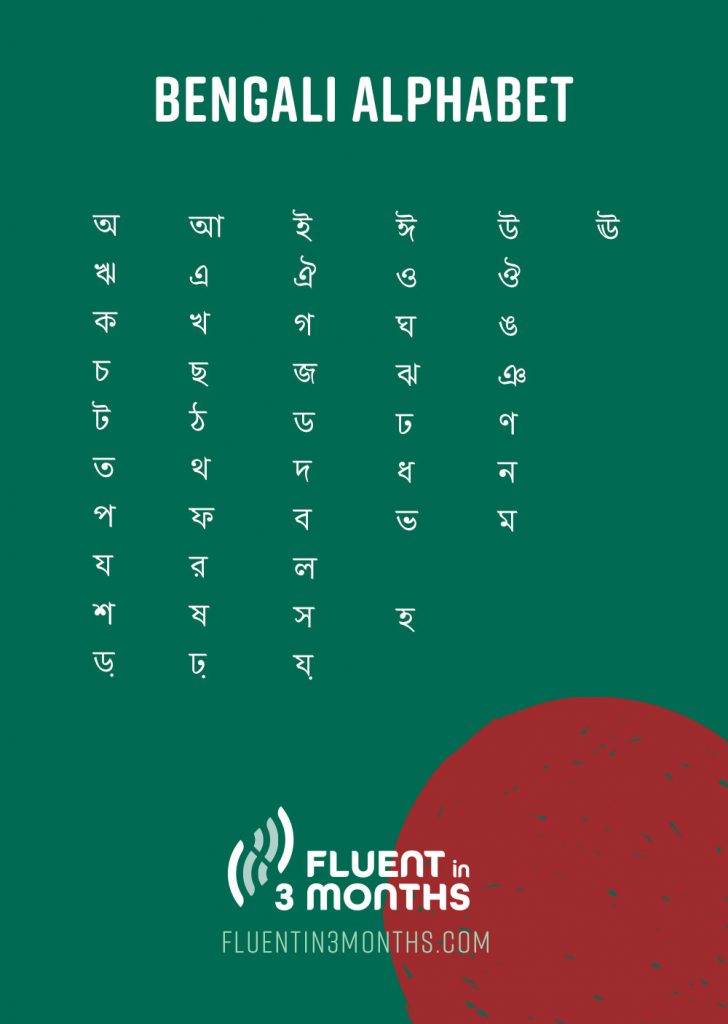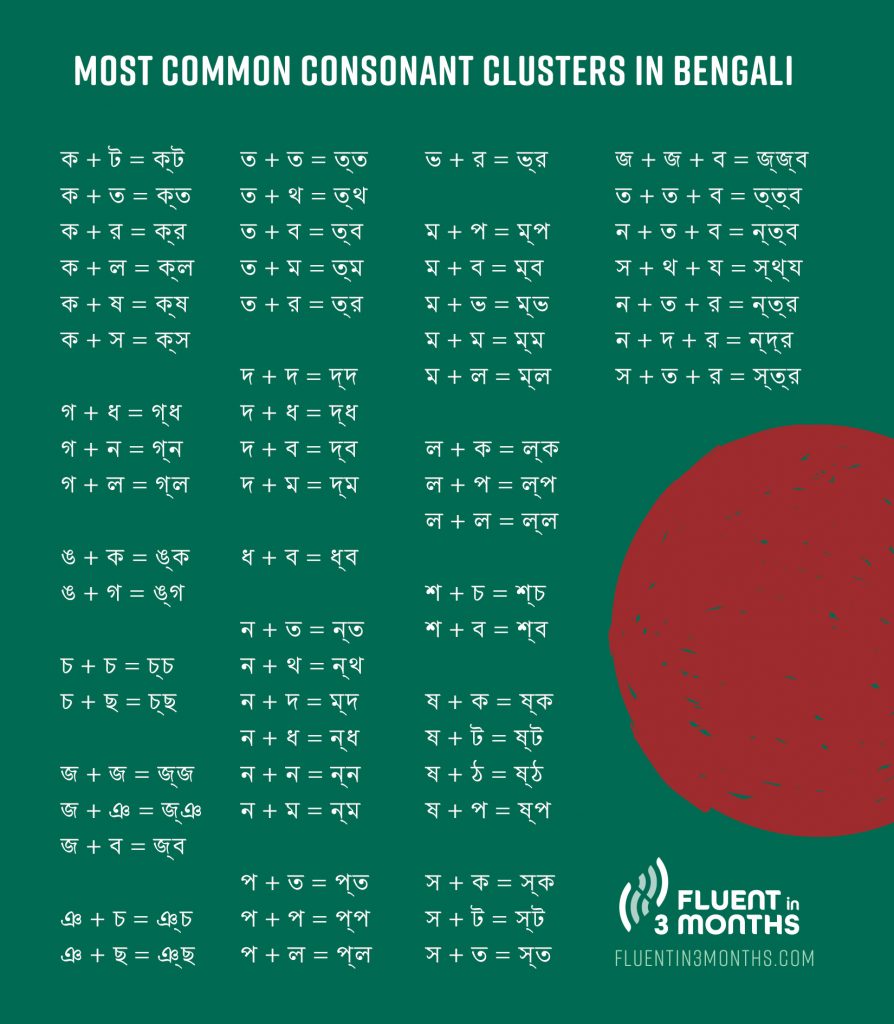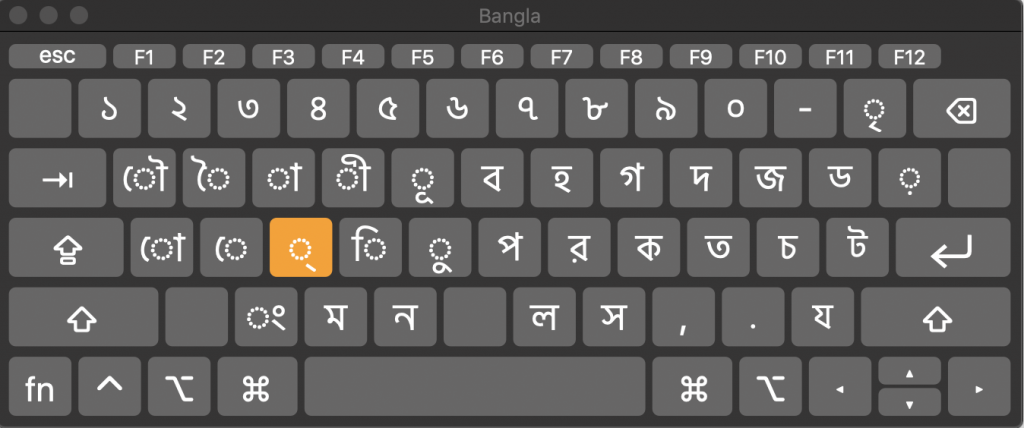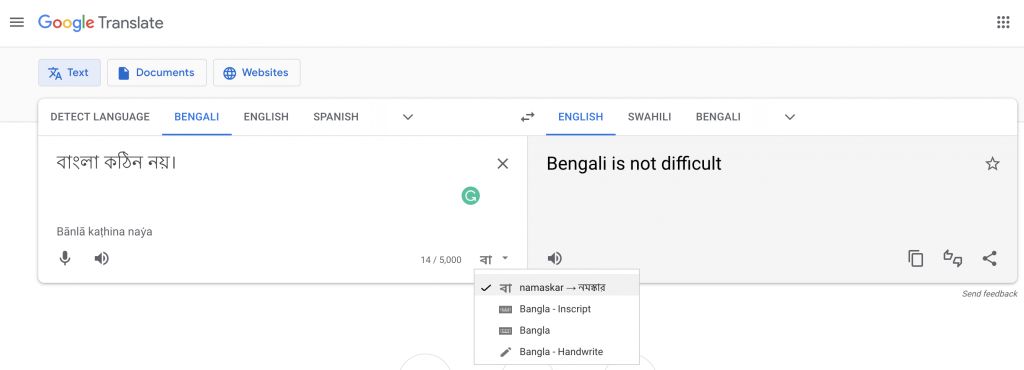If you are interested in learning Bengali, then you’ll certainly want to learn the alphabet.
It might seem difficult at first, but don’t worry!
Bengali is a phonetic alphabet and maybe easier than you think. The best part? If you can read Bengali letters, you can read almost anything.
Table of contents
What Is the Bengali Alphabet?
The Bengali alphabet, also known as the Bangla alphabet and the Bengali-Assamese alphabet, is used to write Bengali, Assamese, and sometimes Sanskrit.

Like Thai and Hindi, it is a Brahmic script. It is similar to Devanagari, the script used in Hindi and Nepali, because a horizontal line called a matra (মাত্রা) connects letters together into one word.
You might think those two alphabets are the same, but there are many differences, like those between the Latin and Cyrillic alphabets.
The trick is to look beneath the matra: Devanagari is often blockier, while Bengali is wavier. For example, the letter m in Devanagari is written as म, but in Bengali it is ম.
In addition, many letters don’t look similar at all. For example, chh is छ in Devanagari, but ছ in Bengali.
Bengali Consonants
There are 32 consonants in Bengali. They are divided into five main types:
- Gutteral (made in the back of your throat)
- Palatal (made with your tongue touching the roof of your mouth)
- Retroflex (made with your tongue curled back)
- Dental (made with the tongue touching the back of your top teeth)
- Labial (made with your lips)
Also, some consonants
- Aspirated, which means they are pronounced with a puff of air.
- Unaspirated, pronounced without a puff of air.
In the romanization, consonants without an “h” are usually unaspirated.
If a vowel is not attached to a consonant, the consonant may be pronounced with an inherent “ɔ” sound (similar as to the “o” in English “on”).
Here is an overview of the Bengali consonants:
Guttural Consonants
- ক (k) – Similar to the English “k” as in “bake.”
- খ (kh) – This is an aspirated ক.
- গ (g) – Similar to the English “g” as in “go.”
- ঘ (gh) – This is an aspirated গ.
- ঙ (ng) – This is like the “ng” in “sing” in English.
- হ (h) – Similar to the English “h” as in “hot.”
Palatal Consonants
- চ (ch) – This one is unaspirated, like the “ch” in “beach.”
- ছ (chh) – This is an aspirated চ, like the “ch” in “chair.”
- জ (j) – Similar to the English “j” as in “joy.” Some Bengali dialects will pronounce this as a “z” instead.
- ঝ (jh) – This is an aspirated জ.
- য (j) – This is pronounced the same as জ.
- ঞ (ñ) – This is often pronounced similar to a nasally “ny” sound (like in “canyon”) in English.
Retroflex Consonants
- ট (ʈ) – This is a retroflex “t” sound. This sound does not have an English equivalent, but try pronouncing a “t” sound with your tongue curled back.
- ঠ (ʈh) – This is an aspirated ট, not the English “th” sound.
- ড (ɖ) – This is a retroflex “d” sound. Try pronouncing a “d” sound with your tongue curled back.
- ঢ (ɖh) – This is an aspirated ড.
- ণ (n or ɳ) – This is historically a retroflex “n” sound, but it is almost always pronounced the same as the dental ন (n) below.
- র ® – This is pronounced similar to a Spanish “r,” in between an English “r” and “l.”
- ড় (ɽ) – This is pronounced with the tongue further back than র.
- ঢ় (ɽh) – This is an aspirated ড়.
Dental Consonants
- ত (t) – This is a dental “t” sound. Pronounce an English “t” sound with your tongue touching behind your upper teeth.
- থ (th) – This is an aspirated ত, not the English “th” sound.
- দ (d) – Similar to the English “d” as in “dog,” but make sure your tongue touches behind your upper teeth.
- ধ (dh) – This is an aspirated দ.
- ন (n) – Similar to the English “n” as in “nose.”
- ল (l) – Similar to the English “l” as in “long.”
Labial Consonants
- প § – Similar to the English “p” as in “potato.”
- ফ (ph or f) – This is an aspirated প, but is sometimes pronounced as an “f” sound instead.
- ব (b) – Similar to the English “b” as in “boy.”
- ভ (bh) – This is an aspirated ব.
- ম (m) – Similar to the English “m” as in “mom.”
Miscellaneous Consonants
- শ (sh) – Similar to the “sh” sound in “shop.”
- ষ (sh) – See note below.
- স (sh) – Note: Historically, শ, ষ, and স all represented distinct sounds. However, in modern Bengali, there is usually no difference.
- য় (y) – This letter can either be the semiconsonant “y” (as in “year”) or silent.
Bengali Vowels
There are 11 vowels in the Bengali alphabet:
- অ (ɔ or o) – Ɔ is like “on,” and o is like “own.”
- আ (a) – Like the “a” in “art.”
- ই (i) – Like the “ee” in “cheese.”
- ঈ (i) – Same as above.
- উ (u) – Like the “oo” as in “hoop.”
- ঊ (u) – Same as above.
- ঋ (ri) – Pronounced like র + ই.
- এ (e or æ) – E is like “e” in “egg,” and æ is like the “a” in “ape.”
- ঐ (oi) – Blend ও and ই.
- ও (o) – Like the “o” in “own.”
- ঔ (ou) – Blend ও and উ.
Historically, ই and ঈ, as well as উ and ঊ, were different sounds. In modern Bengali, they are the same.
Fun fact: Although ঋ would be considered a consonant and a vowel together in English, it is considered a vowel in Bengali.
How to Write in the Bengali Alphabet
Bengali is written from left to right, like in English. If a vowel comes at the beginning of a word, you can write it with the letter above.
Similar to other Brahmic scripts (and even Korean!), vowels are added to “decorate” consonants. If a vowel is pronounced after a consonant, it changes form and connects with the consonant.
This is how they change:
- আ → া
- ই → ি
- ঈ → ী
- উ → ু
- ঊ → ূ
- ঋ → ৃ
- এ → ে
- ঐ → ৈ
- ও → ো
- ঔ → ৌ
The open circle marks where the consonant goes. Remember that because অ is inherent in the consonants, it does not have a vowel mark form.
Therefore, taking the first consonant ক (k), we can create consonant-vowel combinations like this:
- ক (kɔ, ko, or k)
- কা (ka)
- কি (ki)
- কী (ki)
- কু (ku)
- কূ (ku)
- কৃ (kri)
- কে (ke or kæ)
- কৈ (koi)
- কো (ko)
- কৌ (kou)
Occasionally, a consonant-vowel combination will change form:
- গু = গ + ু
- শু = শ + ু
- রু = র + ু
- হু = হ + ু
- রূ = র + ূ
How to Read Consonants without Vowel Marks
Let’s look at ক again. You surely noticed there are three possible ways to read it.
How do you know if you need to pronounce the consonant without a vowel or with an ɔ or an o sound?
There are a few general spelling rules to follow when you’re faced with a consonant that doesn’t have a vowel mark attached:
- At the beginning of a word, it’s often ɔ. However, if the next vowel is an i or u, it’s pronounced o.
Ex. করা (kɔra, “to do”), পরে (pɔre, “after”), কঠিন (koʈhin, difficult)
The Changing য়
The other consonant to watch out for it য় (y). When it is attached to a vowel in the middle of a word, only the vowel is pronounced. Ex. পেয়ালা (peala, “cup).
If য় appears in the middle of a word without a vowel mark, it is usually pronounced like an e. However, it is pronounced o if it directly follows an i or e sound. Ex. পয়সা (poesha, money), তৃতীয় (tritio, “third”).
Finally, ওয়া is pronounced as wa instead of oa. Ex. খাওয়া (khawa, “to eat”).
Other Marks in the Bengali Alphabet
There are a few other marks to introduce in the Bengali alphabet:
- ং (ng): This is the same as ঙ and likewise appears in the middle or at the end of words. Ex. বাংলা (bangla, “Bengali”).
- ঃ: Most commonly, this adds a breathy “h” sound if it appears at the end of a word. Ex. এঃ (eh, “eh!”). If it appears in the middle, it usually doubles the consonant that follows. Ex. দুঃখ (dukkho, “sad”).
- ঁ: This makes the vowel nasal. For example, the only difference between এর (er, regular third-person possessive) and এঁর (ẽr, honorific third-person possessive) is the nasalized vowel. Nasalization is much more common in dialects around Kolkata than in Bangladesh.
- ্: A consonant with this beneath it is pronounced without a vowel. For example, ক্ can only be pronounced as k.
- ৎ (t): This is the unaspirated dental “t” (ত). It sometimes appears in the middle or end of words. Ex. শরৎ (shɔrɔt, fall/autumn).
- র্ক: This dash above ক is র connected before another consonant. It can follow any consonant, but cannot be typed independently on all computers. This example makes a rk sound. Another example would be বর্ষা (borsha, “rain”). It is also written as র্.
- ্র ®: This is র after another consonant. Ex. প্রথম (prothom, “first”).
- ্য: This is য connected to a consonant, but it doesn’t have a j sound. When it is in the middle or end of a word, it doubles the consonant before it. Ex. ধন্যবাদ (dhonnobad, “thank you), সাহিত্য (shahitto, “literature”). At the beginning of a word, it usually creates an æ sound, unless the next vowel is an i or u sound… Ex. ব্যথা (bætha, “pain”).
Consonant Clusters in the Bengali Alphabet
As you got a taste of above, sometimes consonants can connect to other consonants and change forms. Some are easy to understand. Here are a few basic examples:
- ল (l) + প § = ল্প (lp). This is used in গল্প (golpo, “story”).
- চ (ch) + চ (ch) = চ্চ (cch–pronounced like a harder, double consonant). This is used in বাচ্চা (baccha, child).
However, sometimes the form changes and they are difficult to understand without memorizing the combination. Here are a few common examples:
- ঙ (ng) + গ (g) = ঙ্গ (ng). There is no difference in sound. This is used in সঙ্গে (shɔnge, “together”).
- দ (d) + ধ (dh) = দ্ধ (ddh). This is used in যুদ্ধ (juddho, “war”).
Sometimes, the pronunciation also changes, as described below.
Adding ব or ম
Sometimes the b and m sounds are not pronounced if they are clustered after another consonant. Ex. দ্বার (dar, “door), formed with দ + ব to make দ্ব.
In addition, if either is clustered behind a consonant in the middle or end of a word, it doubles the preceding consonant. Ex. গ্রীষ্ম (grissho, “summer”).
These special uses are remnants of Bengali as used for Sanskrit and need to just be memorized.
্র Sometimes Also Doubles Consonants
Adding ্র to a consonant in the middle or end of a word doubles the preceding consonant. It still also produces the r sound. Ex. সমুদ্র (shomuddro, “ocean”).
When স, শ, and ষ Are S
When স, শ, or ষ is clustered behind a ত, থ, খ, ন, র, ল, it becomes an s sound rather than a sh sound. This happens most commonly with স. Ex. ব্যস্ত (baesto, “busy”), made from স + ত to form স্ত.
ক্ষ and জ্ঞ Look and Sound Special
These two are common clusters that both look and sound differently from what you would expect.
ক্ষ is made from ক + ষ, but is pronounced kkh when it comes in the middle or end of a word. Ex. শিক্ষক (shikkhok, “teacher”). At the beginning, it’s pronounced kh, the same as খ. Ex. ক্ষমা (khoma, forgiveness).
জ্ঞ is made from জ + ঞ, but is pronounced g at the beginning of words, and gg at the middle and end. It can also make an া turn into an æ sound. Ex. জ্ঞান (gæn, “knowledge”), অভিজ্ঞতা (ɔbhiggota, “experience”).
Most Common Consonant Clusters in Bengali
Below is a list of some of the most common consonant clusters in Bengali. Clusters of two consonants are the most common, but it is possible to also have three.
Don’t worry about memorizing them all at once–many of them are obvious or follow common patterns, and the rest you can learn with practice.
They are presented in Bengali alphabetical order.
ক + ট = ক্ট
ক + ত = ক্ত
ক + র = ক্র
ক + ল = ক্ল
ক + ষ = ক্ষ
ক + স = ক্স
গ + ধ = গ্ধ
গ + ন = গ্ন
গ + ল = গ্ল
ঙ + ক = ঙ্ক
ঙ + গ = ঙ্গ
চ + চ = চ্চ
চ + ছ = চ্ছ
জ + জ = জ্জ
জ + ঞ = জ্ঞ
জ + ব = জ্ব
ঞ + চ = ঞ্চ
ঞ + ছ = ঞ্ছ
ঞ + জ = ঞ্জ
ঞ + ঝ = ঞ্ঝ
ট + ট = ট্ট
ড + ড = ড্ড
ণ + ট = ণ্ট
ণ + ঠ = ণ্ঠ
ণ + ড = ণ্ড
ত + ত = ত্ত
ত + থ = ত্থ
ত + ব = ত্ব
ত + ম = ত্ম
ত + র = ত্র
দ + দ = দ্দ
দ + ধ = দ্ধ
দ + ব = দ্ব
দ + ম = দ্ম
ধ + ব = ধ্ব
ন + ত = ন্ত
ন + থ = ন্থ
ন + দ = ন্দ
ন + ধ = ন্ধ
ন + ন = ন্ন
ন + ম = ন্ম
প + ত = প্ত
প + প = প্প
প + ল = প্ল
ফ + ল = ফ্ল
ব + জ = ব্জ
ব + দ = ব্দ
ব + ধ = ব্ধ
ব + ব = ব্ব
ব + ল = ব্ল
ভ + র = ভ্র
ম + প = ম্প
ম + ব = ম্ব
ম + ভ = ম্ভ
ম + ম = ম্ম
ম + ল = ম্ল
ল + ক = ল্ক
ল + প = ল্প
ল + ল = ল্ল
শ + চ = শ্চ
শ + ব = শ্ব
ষ + ক = ষ্ক
ষ + ট = ষ্ট
ষ + ঠ = ষ্ঠ
ষ + প = ষ্প
স + ক = স্ক
স + ট = স্ট
স + ত = স্ত
স + থ = স্থ
স + ন = স্ন
স + প = স্প
স + ব = স্ব
হ + ণ = হ্ণ
হ + ম = হ্ম
জ + জ + ব = জ্জ্ব
ত + ত + ব = ত্ত্ব
ন + ত + ব = ন্ত্ব
স + থ + য = স্থ্য
ন + ত + র = ন্ত্র
ন + দ + র = ন্দ্র
স + ত + র = স্ত্র
Here’s an infographic you can save and/or print to use during your study sessions:

How to Type in the Bengali Alphabet
Many computers today come with the Bengali alphabet already as an option to type in your language settings.
For example, I use a Macbook Pro, and this is what my keyboard viewer looks like on the Bengali setting:

By pressing shift, I get more typing options. To create consonant clusters, I type the first consonant and then the ্ highlighted in orange. For example, to type ক্ক, I would type ক + ্ + ক.
However, many people prefer using Google Translate to type in the Bengali alphabet.
As long as you have the input method set to the first option (look for the বা symbol below), you can type Bengali in the Latin alphabet. Google will convert your letters and words into Bengali. That’s similar to typing in Chinese or Japanese.

In casual spaces, such as on social media, many Bengalis also forgo typing in the Bengali alphabet. Instead, they write Bengali using the Latin alphabet.
However, Bengali romanization is not standardized, and not every sound is easily expressed with the basic Latin alphabet. This can cause some problems.
Sometimes, the words can be confused with others so much that they make a hilariously distorted meaning. This is called Murad Takla (মুরাদ টাকলা) in Bengali.
I myself have had an interesting experience with Murad Takla. While on a long-distance bus in Bangladesh, I saw a local bus with “Mama Vagina” printed on it in large, bright Latin letters. I was shocked since sex is a taboo subject in Bangladesh, so I couldn’t imagine why it would be so boldly printed on the side of a bus. My Bangladeshi friend explained to me that the bus owner probably meant মামা ভাগিনা (mama bhagina, “uncle and nephew”) instead.
With Practice, Reading and Writing in Bengali Is Easy!
Bengali may look difficult at first, but once you remember the basic rules and combinations, it’s easier than you think. Once I started building my vocabulary, I quickly caught on. You can too!
The post The Bengali Alphabet: Your In-Depth Guide appeared first on Fluent in 3 Months.


0 Commentaires